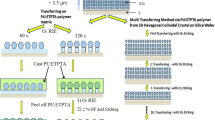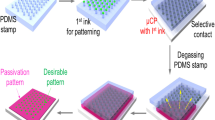Abstract
There is a growing interest on the fabrication of bacteria and virus microarray owing to their great potential in many biological applications ranging from diagnostic devices to advanced platforms for fundamental studies on molecular biology. Over the past decade, a number of studies with regard to the biomolecular patterning have been presented. Capillary force lithography (CFL) for polymeric thin films can provide well-ordered microarray structures over a large area in a facile and cost-efficient way while maintaining its biocompatibility during a process. Patterned polymeric structures can be utilized either to physical barriers for the confinement of bacteria or to physicochemical template for the subsequent binding of viruses. In this chapter, we have shown that the patterned structures of poly(ethylene glycol) (PEG) containing polymer enables a selective binding of Escherichia coli, leading to a physically guided microarray of bacteria. Additionally, we demonstrate the fabrication of virus microarray of M13 viruses via electrostatic interactions with a prepatterned microstructure of polyelectrolyte multilayers.
Access this chapter
Tax calculation will be finalised at checkout
Purchases are for personal use only
Similar content being viewed by others
References
Falconnet, D., Csucs, G., Grandin, H. M., and Textor, M. (2006) Surface engineering approaches to micropattern surfaces for cell-based assays. Biomaterials 27, 3044–3063.
Rowan, B., Wheeler, M. A., and Crooks, R. M. (2002) Patterning bacteria within hyperbranched polymer film templates. Langmuir 18, 9914–9917.
Lee, K. B., Kim, E. Y., Mirkin, C. A., and Wolinsky, S. M. (2004) The use of nanoarrays for highly sensitive and selective detection of human immunodeficiency virus type 1 in plasma. Nano Lett. 4, 1869–1872.
Cheung, C. L., Camarero, J. A., Woods, B. W., Lin, T., Johnson, J. E., and De Yoreo, J. J. (2003) Fabrication of assembled virus nanostructures on templates of chemoselective linkers formed by scanning probe nanolithography. J. Am. Chem. Soc. 125, 6848–6849.
Koh, W. G., Revzin, A., Simonian, A., Reeves, T., and Pishko, M. (2003) Control of mammalian cell and bacteria adhesion on substrates micropatterned with poly(ethylene glycol) hydrogels. Biomed. Microdevices 5, 11–19.
Wood, M. J. and Moellering, Jr. R. C. (2003) Microbial resistance: bacteria and more. Clin. Infect. Dis. 36, S2–S3.
Suh, K. Y., Kim, Y. S., and Lee, H. H. (2001) Capillary force lithography. Adv. Mater. 13, 1386–1389.
Suh, K. Y., Khademhosseini, A., Yoo, P. J., and Langer, R. (2004) Patterning and separating infected bacteria using host-parasite and virus-antibody interactions. Biomed. Microdevices 6, 223–229.
Suh, K. Y., Khademhosseini, A., Jon, S., and Langer, R. (2006) Direct confinement of individual viruses within polyethylene glycol (PEG) nanowells. Nano Lett. 6, 1196–1201.
Jon, S., Seong, J., Khademhosseini, A., Tran, T. N. T., Laibinis, P. E., and Langer, R. (2003) Construction of nonbiofouling surfaces by polymeric self-assembled monolayers. Langmuir 19, 9989–9993.
Hammond, P. T. (2004) Form and function in multilayer assembly: new applications at the nanoscale. Adv. Mater. 16, 1271–1293.
Yoo, P. J., Nam, K. T., Qi, J., Lee, S. K., Park, J., Belcher, A. M., and Hammond, P. T. (2006) Spontaneous assembly of viruses on multilayered polymer surfaces. Nat. Mater. 5, 234–240.
Yoo, P. J., Nam, K. T., Belcher, A. M., and Hammond, P. T. (2008) Solvent-assisted patterning of polyelectrolyte multilayers and selective deposition of virus assemblies. Nano Lett. 8, 1081–1089.
Author information
Authors and Affiliations
Editor information
Editors and Affiliations
Rights and permissions
Copyright information
© 2011 Springer Science+Business Media, LLC
About this protocol
Cite this protocol
Yoo, P.J. (2011). Fabrication of Bacteria and Virus Microarrays Based on Polymeric Capillary Force Lithography. In: Khademhosseini, A., Suh, KY., Zourob, M. (eds) Biological Microarrays. Methods in Molecular Biology, vol 671. Humana Press, Totowa, NJ. https://doi.org/10.1007/978-1-59745-551-0_8
Download citation
DOI: https://doi.org/10.1007/978-1-59745-551-0_8
Published:
Publisher Name: Humana Press, Totowa, NJ
Print ISBN: 978-1-934115-95-4
Online ISBN: 978-1-59745-551-0
eBook Packages: Springer Protocols




